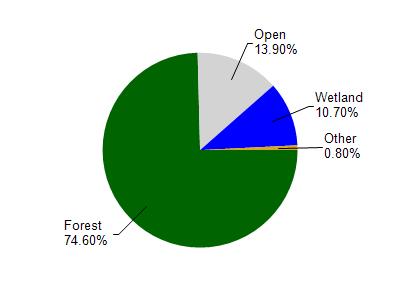Vilas
No
No
No
Fish and Aquatic Life
Historical Description
Source: 1963, Surface Water Resources of Vilas County Star (Little) Lake, T-41-N, R-8-E, Section 10
Little Star Lake is a drainage lake of moderate fertility, having slightly alkaline, clear water of low transparency. Thebottom materials consist mostly of sand, with gravel and muck. The inlet stream is shallow, whereas, the outlet stream is navigable. The principal fish species present are the muskellunge, northern pike, walleye, largemouth bass, smallmouth bass and pan fish. The lake is considered to have a use problem in regard to aquatic vegetation and algae blooms. Public access is possible by using the navigable outlet or by use of a county road, Highway K, with parking facilities. Public use facilities consist of one resort and one boat rental establishment. There is one cottage located on the shore line.
Area = 93 Surface Acres, Maximum Depth = 9 feet
Date 1963
Author Surface Water Inventory Of Wisconsin
General Condition
WQ Trend Comment: This beach was assessed for the 2016 Impaired Waters List and E. coli data did not exceed 2016 WisCALM listing criteria.
Date 2015
Author Wdnr Water Quality
Condition
Wisconsin has over 84,000 miles of streams, 15,000 lakes and milllions of acres of wetlands. Assessing the condition of this vast amount of water is challenging. The state's water monitoring program uses a media-based, cross-program approach to analyze water condition. An updated monitoring strategy (2015-2020) is now available. Compliance with Clean Water Act fishable, swimmable standards are located in the Executive Summary of Water Condition in 2018. See also the 'monitoring and projects' tab.
Reports
Recommendations
Monitor Water Quality or Sediment
Insufficient TP data to make assessment. Further monitoring for TP is recommended.
Management Goals
Wisconsin's Water Quality Standards provide qualitative and quantitative goals for waters that are protective of Fishable, Swimmable conditions [Learn more]. Waters that do not meet water quality standards are considered impaired and restoration actions are planned and carried out until the water is once again fishable and swimmable
Management goals can include creation or implementation of a Total Maximum Daily Load analysis, a Nine Key Element Plan, or other restoration work, education and outreach and more. If specific recommendations exist for this water, they will be displayed below online.
Monitoring
Monitoring the condition of a river, stream, or lake includes gathering physical, chemical, biological, and habitat data. Comprehensive studies often gather all these parameters in great detail, while lighter assessment events will involve sampling physical, chemical and biological data such as macroinvertebrates. Aquatic macroinvertebrates and fish communities integrate watershed or catchment condition, providing great insight into overall ecosystem health. Chemical and habitat parameters tell researchers more about human induced problems including contaminated runoff, point source dischargers, or habitat issues that foster or limit the potential of aquatic communities to thrive in a given area. Wisconsin's Water Monitoring Strategy was recenty updated.
Grants and Management Projects
Monitoring Projects
| WBIC | Official Waterbody Name | Station ID | Station Name | Earliest Fieldwork Date | Latest Fieldwork Date | View Station | View Data |
|---|
| 1593200 | Little Star Lake | 10006158 | Little Star Lake | 8/29/2000 | 8/27/2024 | Map | Data |
| 1593200 | Little Star Lake | 644062 | Little Star Lake - Deepest Spot | 8/21/1979 | 8/28/2017 | Map | Data |
| 1593200 | Little Star Lake | 10021101 | Little Star Lake - State Park Beach | 6/25/2002 | 8/23/2010 | Map | Data |
|

Watershed Characteristics
Little Star Lake is located in the St. Germain River watershed which is 70.11 mi². Land use in the watershed is primarily forest (74.60%), open (13.90%) and a mix of wetland (10.70%) and other uses (0.80%). This watershed has 39.57 stream miles, 3,101.31 lake acres and 5,357.65 wetland acres.
Nonpoint Source Characteristics
This watershed is ranked Not Ranked for runoff impacts on streams, Medium for runoff impacts on lakes and Low for runoff impacts on groundwater and therefore has an overall rank of Low. This value can be used in ranking the watershed or individual waterbodies for grant funding under state and county programs.However, all waters are affected by diffuse pollutant sources regardless of initial water quality. Applications for specific runoff projects under state or county grant programs may be pursued. For more information, go to surface water program grants.